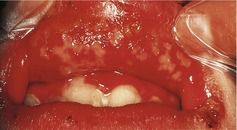Case• 28. A very painful mouth
SUMMARY
A 20-year-old man presents to you in your general dental practice, feeling ill and with a very sore mouth.
History
Complaint
The patient complains of pain which is preventing eating and hampering drinking. He also feels unwell.
History of complaint
He first noticed feeling unwell 4 days previously and thought he had ‘flu. He was slightly feverish and developed a headache. His mouth was sore but it was not until about 1 day later that it became very painful. Because he felt unable to take time off work, he took the remains of a course of an unknown oral antibiotic which had been prescribed for his brother who had an infected cut on his arm. This did not appear to have led to any improvement. He has had no similar attacks before.
Medical history
The patient is otherwise fit and well.
Examination
Extraoral examination
The patient has enlarged cervical lymph nodes that are slightly tender, mobile but soft or firm rather than hard. Apart from this finding no abnormalities are found in a routine examination of the head, neck and hands.
Intraoral examination
▪ What do you see inFigure 28.1?
 |
| Fig. 28.1 |
There are numerous ulcers on the labial mucosa which have the following characteristics:
| Site | Labial mucosa and attached gingiva |
| Size | A few millimetres in diameter |
| Shape | Well defined, rounded, sometimes coalescing to form larger irregular ulcers |
| Colour | Covered by a yellow-grey fibrin ulcer slough, no well-defined rim of periulcer erythema |
| Background | The surrounding mucosa appears uniformly inflamed |
In addition, one large ulcer lies at the commissure and there are small bloodstained crusts around the lips.
If you were able to examine the patient you would discover that more ulcers affect much of the oral mucosa, including the gingivae, palate and tongue, and that they extend back into the oropharynx.
▪ Give a differential diagnosis on the basis of the information you have so far.
• Primary herpetic gingivostomatitis
• Erythema multiforme.
▪ Justify this differential diagnosis.
Primary herpetic gingivostomatitis and other oral viral infections typically cause multiple round small ulcers of acute onset, sometimes coalescing, on a background of inflamed mucosa. The patient feels unwell and has enlarged tender lymph nodes suggesting infection. Primary Herpes simplex infection usually affects much of the mucosa and has a predilection for the keratinized masticatory mucosa of the gingiva. The patient is older than is normally expected for a primary infection. However, the average age of patients with this infection has increased over the last few decades because improved living conditions have resulted in fewer individuals coming into contact with the virus during their childhood.
Erythema multiforme (Stevens–Johnson syndrome) is possible. The acute onset and bloody crusts on the lips suggest this diagnosis and the age of the patient is compatible. However, the distribution of ulcers is not particularly suggestive of this condition. Erythema multiforme affects primarily the lips and nonkeratinized lining mucosa of the anterior mouth, and the ulcers have ragged margins, whereas the irregular ulcers in the picture seem to be formed by coalescence of small round ulcers. A trigger for erythema multiforme is sometimes identified and antibiotics, particularly sulphonamides, are sometimes the cause. This patient has had recent antibiotics, but only after the symptoms appeared. Erythema multiforme is typically recurrent and the history of previous attacks and their periodicity is important in making the diagnosis. However, in a first attack the features may be milder and, as in this case, there is no history of similar attacks.
▪ What diagnoses have you discounted and why?
Other oral viral infections do not produce a clinical picture of this severity. Herpangina and hand, foot and mouth disease are milder and usually affect the soft palate of children. Varicella zoster would be expected to cause chicken pox in this age group though children are the age group more typically affected; oral zoster usually affects elderly patients and is unilateral.
Herpetiform aphthous stomatitis should be considered but is readily excluded. The ulcers may be numerous, small and coalescing and may have an erythematous background. However they are usually limited to the anterior or posterior of the mouth, do not affect keratinized mucosa and are not accompanied by systemic illness. Attacks are recurrent.
Stay updated, free dental videos. Join our Telegram channel

VIDEdental - Online dental courses


